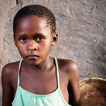Poverty Is a Lie

This article is an excerpt from the eighth chapter of the Compassion International book Poverty and used by permission.
Bryant Myers describes poverty in terms of relationships damaged by sin:
• Our broken relationship with God is the essence of spiritual poverty.
• Our broken relationship with others and with community is social poverty.
• Our broken relationship with our environment and our broken self-view (or relationship with self) have been damaged by sin.
Myers states, “Poverty is a result of relationships that do not work, that are not just, that are not for life, that are not harmonious or enjoyable.”31 In short, poverty is a consequence of sin.
Poverty Is a Lie
Compassion President Dr. Wess Stafford offers a view of poverty that has some similarities to those described above. Stafford describes the marred identity and disempowerment as being caused by false messages. He stresses that these false messages have their greatest impact during childhood.
At its very core, poverty is a mindset that goes far beyond the tragic circumstances. It is the cruel, destructive message that gets whispered into the ears of millions by the enemy Satan himself: “Give up! You don’t matter. Nobody cares about you. Look around you: Things are terrible. Always have been, always will be. Think back. Your grandfather was a failure. Your parents couldn’t protect or take care of you. Now it’s your turn. You, too, will fail. So just give up!”32
When a child (or adult) believes that lie, then he is poor. Poverty described in these terms is primarily an internal condition resulting from an external message of oppression. The internal condition is one of disempowerment, fatalism, hopelessness and lack of initiative. The person in this condition will often be a victim of his circumstances rather than an agent of positive change in his community. That person’s extremely low self-view will translate into a low regard for others and likely into damaged relationships. Damaged relationships then reciprocate and reinforce the message of worthlessness. The belief that “it won’t get any better” may undermine initiative. It may not matter how many opportunities are created, because the effort of striving, risking and capitalizing on those opportunities requires a belief in the possibility of a better future. The majority of individuals in that state are incapable of transformational development. To sum it up in one word, they lack hope, and hope is a major engine of growth and wellness.
The marred identity includes a self-view of powerlessness, of being victim to circumstance, of not only low self-esteem but also a projection of low value on others in community. When one sees poverty as having its root in human identity (self-concept), then it profoundly impacts the strategies chosen for development.
When one defines poverty primarily as an internal condition resulting from external devaluing messages, it holds significant implications for poverty-fighting strategies. One must ask: How and when did the internal condition become entrenched? How can “the lie” be exposed and the person freed from its oppression? Can we prevent it from being heard or being believed?
It also becomes clear that when the lie is deeply entrenched in later stages of human development (adults) it is difficult to reverse. However, intervening early in human development, during childhood, offers the best opportunity to reverse or prevent the lie from gaining traction in the identity-shaping stages of human development.
There are pivotal moments in human development, defining moments, that shape long-term self-view and identity. Those pivotal moments must be won by truth and not by the lie. The lie speaks in abuse; the truth must protect. The lie speaks by ignoring; the truth must listen. The lie criticizes; the truth must praise. The voice of truth must carry throughout the early and most vulnerable stage of human development to break the power of the lie.
In cases like these, the poverty-fighting strategies are driven by the question: How do we introduce the voice and message of truth? The voice that says, “You do matter! Your thoughts and feelings are important! Don’t give up! It can get better! You are full of God-given potential to change it!” The lie can be a pervasive voice and a long-term presence in the environment of the child. The message of truth, spoken and demonstrated in the life of the child, must be equally persistent and focused in order to prevail.
As Stafford described it, poverty is defeated when the young lady who grew up in the slum sees the damage in her world and says, “See what’s going on over there? That’s wrong — and I can fix it.”33 The strategic importance of childhood in social transformation is addressed in a separate Compassion Ministry Philosophy Paper.
The statement “poverty is a lie” is not meant to deny the reality of poverty. Poverty is absolutely real. Nor is the statement meant to imply that overcoming poverty is as simple as a change of mind. The statement certainly does not mean to blame the victims in the sense that they were the ones who chose to believe this lie. Rather, the concept conveys the idea that we are surrounded by false messages about who we are — about our nature, power and value. These messages mask the truth of our identity: We are people made in the image of God, granted unique talents by God and capable of receiving the Holy Spirit. We are dearly loved by God. All of us believe the lie to some degree, but for the poor, it is debilitating.
Endnotes
Chapter 8 - Internal Conditions and External Circumstances of Poverty
31. Myers, B. (1999). Walking with the poor. Maryknoll, NY: Orbis.
32. Stafford, W. (2007). Too small to ignore. Colorado Springs: WaterBrook Press.
33. Ibid.









comments